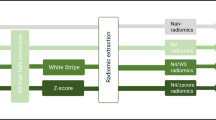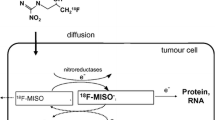Abstract
Proton magnetic resonance spectroscopy (1H-MRS) has shown promise in distinguishing recurrent high-grade glioma from posttreatment radiation effect (PTRE). The purpose of this study was to establish objective 1H-MRS criteria based on metabolite peak height ratios to distinguish recurrent tumor (RT) from PTRE. A retrospective analysis of magnetic resonance imaging and 1H-MRS data was performed. Spectral metabolites analyzed included N-acetylaspartate, choline (Cho), creatine (Cr), lactate (Lac), and lipids (Lip). Quantitative 1H-MRS criteria to differentiate RT from PTRE were identified using 81 biopsy-matched spectral voxels. A receiver operating characteristic curve analysis was conducted for all metabolite ratio combinations with the pathology diagnosis as the classification variable. Forward discriminant analysis was used to identify ratio variables that maximized the correct classification of RT versus PTRE. Our results were applied to 205 records without biopsy-matched voxels to examine the percent agreement between our criteria and the radiologic diagnoses. Five ratios achieved an acceptable balance [area under the curve (AUC) ≥ 0.700] between sensitivity and specificity for distinguishing RT from PTRE, and each ratio defined a criterion for diagnosing RT. The ratios are as follows: Cho/Cr > 1.54 (sensitivity 66%, specificity 79%), Cr/Cho ≤ 0.63 (sensitivity 65%, specificity 79%), Lac/Cho ≤ 2.67 (sensitivity 85%, specificity 58%), Lac/Lip ≤ 1.64 (sensitivity 54%, specificity 95%), and Lip/Lac > 0.58 (sensitivity 56%, specificity 95%). Application of our ratio criteria in prospective studies may offer an alternative to biopsy or visual spectral pattern recognition to distinguish RT from PTRE in patients with gliomas.



Similar content being viewed by others
Abbreviations
- AUC:
-
Area under the curve
- Cho:
-
Choline
- Cr:
-
Creatine
- FLAIR:
-
Fluid attenuation inversion recovery
- GBM:
-
Glioblastoma multiforme
- 1H-MRS:
-
Proton magnetic resonance spectroscopy
- Lac:
-
Lactate
- Lip:
-
Lipids
- MRI:
-
Magnetic resonance imaging
- NAA:
-
N-acetylaspartate
- PTRE:
-
Posttreatment radiation effect
- RT:
-
Recurrent tumor
References
Stupp R, Mason WP, van den Bent MJ, Weller M, Fisher B, Taphoorn MJ, Belanger K, Brandes AA, Marosi C, Bogdahn U, Curschmann J, Janzer RC, Ludwin SK, Gorlia T, Allgeier A, Lacombe D, Cairncross JG, Eisenhauer E, Mirimanoff RO (2005) Radiotherapy plus concomitant and adjuvant temozolomide for glioblastoma. N Engl J Med 352:987–996. doi:10.1056/NEJMoa043330
Ostrom QT, Bauchet L, Davis FG, Deltour I, Fisher JL, Langer CE, Pekmezci M, Schwartzbaum JA, Turner MC, Walsh KM, Wrensch MR, Barnholtz-Sloan JS (2014) The epidemiology of glioma in adults: a “state of the science” review. Neuro-oncology 16:896–913. doi:10.1093/neuonc/nou087
Brandsma D, Stalpers L, Taal W, Sminia P, van den Bent MJ (2008) Clinical features, mechanisms, and management of pseudoprogression in malignant gliomas. Lancet Oncol 9:453–461. doi:10.1016/S1470-2045(08)70125-6
de Wit MC, de Bruin HG, Eijkenboom W, Sillevis Smitt PA, van den Bent MJ (2004) Immediate post-radiotherapy changes in malignant glioma can mimic tumor progression. Neurology 63:535–537
Chamberlain MC, Glantz MJ, Chalmers L, Van Horn A, Sloan AE (2007) Early necrosis following concurrent Temodar and radiotherapy in patients with glioblastoma. J Neurooncol 82:81–83. doi:10.1007/s11060-006-9241-y
Castillo M, Kwock L, Mukherji SK (1996) Clinical applications of proton MR spectroscopy. AJNR Am J Neuroradiol 17:1–15
Ricci PE, Pitt A, Keller PJ, Coons SW, Heiserman JE (2000) Effect of voxel position on single-voxel MR spectroscopy findings. AJNR Am J Neuroradiol 21:367–374
Lee PL, Gonzalez RG (2000) Magnetic resonance spectroscopy of brain tumors. Curr Opin Oncol 12:199–204
Guo J, Yao C, Chen H, Zhuang D, Tang W, Ren G, Wang Y, Wu J, Huang F, Zhou L (2012) The relationship between Cho/NAA and glioma metabolism: implementation for margin delineation of cerebral gliomas. Acta Neurochir 154:1361–1370. doi:10.1007/s00701-012-1418-x (discussion 1370)
Hollingworth W, Medina LS, Lenkinski RE, Shibata DK, Bernal B, Zurakowski D, Comstock B, Jarvik JG (2006) A systematic literature review of magnetic resonance spectroscopy for the characterization of brain tumors. AJNR Am J Neuroradiol 27:1404–1411
Preul MC, Caramanos Z, Collins DL, Villemure JG, Leblanc R, Olivier A, Pokrupa R, Arnold DL (1996) Accurate, noninvasive diagnosis of human brain tumors by using proton magnetic resonance spectroscopy. Nat Med 2:323–325
Preul MC, Caramanos Z, Leblanc R, Villemure JG, Arnold DL (1998) Using pattern analysis of in vivo proton MRSI data to improve the diagnosis and surgical management of patients with brain tumors. NMR Biomed 11:192–200
Moller-Hartmann W, Herminghaus S, Krings T, Marquardt G, Lanfermann H, Pilatus U, Zanella FE (2002) Clinical application of proton magnetic resonance spectroscopy in the diagnosis of intracranial mass lesions. Neuroradiology 44:371–381. doi:10.1007/s00234-001-0760-0
Usenius T, Usenius JP, Tenhunen M, Vainio P, Johansson R, Soimakallio S, Kauppinen R (1995) Radiation-induced changes in human brain metabolites as studied by 1 H nuclear magnetic resonance spectroscopy in vivo. Int J Radiat Oncol Biol Phys 33:719–724. doi:10.1016/0360-3016(95)02011-Y
Chuang MT, Liu YS, Tsai YS, Chen YC, Wang CK (2016) Differentiating radiation-induced necrosis from recurrent brain tumor using MR perfusion and spectroscopy: a meta-analysis. PLoS ONE 11:e0141438. doi:10.1371/journal.pone.0141438
Hu LS, Eschbacher JM, Heiserman JE, Dueck AC, Shapiro WR, Liu S, Karis JP, Smith KA, Coons SW, Nakaji P, Spetzler RF, Feuerstein BG, Debbins J, Baxter LC (2012) Reevaluating the imaging definition of tumor progression: perfusion MRI quantifies recurrent glioblastoma tumor fraction, pseudoprogression, and radiation necrosis to predict survival. Neuro-oncology 14:919–930. doi:10.1093/neuonc/nos112
Funding
Funds from Newsome United Kingdom Chair in Neurosurgery Research held by Dr. Preul.
Author information
Authors and Affiliations
Corresponding author
Ethics declarations
Conflict of interest
None.
Additional information
Ian D. Crain and Petra S. Elias have contributed equally to this work.
Rights and permissions
About this article
Cite this article
Crain, I.D., Elias, P.S., Chapple, K. et al. Improving the utility of 1H-MRS for the differentiation of glioma recurrence from radiation necrosis. J Neurooncol 133, 97–105 (2017). https://doi.org/10.1007/s11060-017-2407-y
Received:
Accepted:
Published:
Issue Date:
DOI: https://doi.org/10.1007/s11060-017-2407-y




